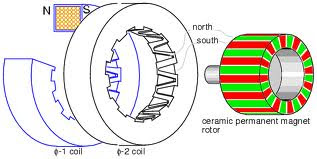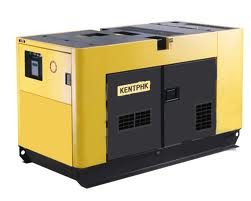SUBSCRIBE To Our Mail List To Get This Article In PDF
Faraday's Law of Induction is the principle under which electric generators work. Every magnet has a field of waves around it. Electric current is generated if this magnetic field is disturbed. The electric current can flow along a closed loop of wire. The magnetic field is disturbed by any form of physical motion or force. So electric current will flow through a circuit of wire is a magnet nearby is disturbed by motion or force. Pieces of ferromagnetic metals such as nickel or steel can be made to vibrate near the magnet and this will keep its magnetic field in flux, with a continuous and consequent flow of electric current in a circuit of wire.
This principle is routinely demonstrated in Physics laboratories of Schools. It can be scaled up for a range of industrial applications. The smallest of the common templates is used in a musical instrument such as an electric guitar.
Larger ones power common hand tools. One can have a set large enough to supply power to an entire house or even a building. Large power plants that supply electricity to factories and entire cities also work on the same principle.
However moving wires over a magnet or a magnet within a coil of wire, on an industrial scale requires tremendous mechanical energy.
This can be provided by a battery that has stored power for electric generators for home use or on a shop floor. Cascading water as in a thermal plant, coal in a hydrocarbon power plant, fossil fuel such as diesel or atomic energy can be used for mechanical energy in large power generating stations and complexes. Energy is always transmitted through a shaft. Power Plants are large and controversial for their impact on the environment and on finite resources. Electric generators produce alternating current because the magnetic field is disturbed in to and fro manner. Though there is no limit in theory to the dimensions of an electric generator and how much electricity it can produce, there are practical limitations. Wire resistance, heat generation and complications of magnetic fields in flux, are the major factors.
A new form of electric generation is through fuel cells. These arouse great interest because of their ability to produce electric power without pollution. Fuel cells may replace other types of electric power generators in many fields soon. A fuel cell produces electricity by combining oxygen and hydrogen to produce water. Oxygen comes from air and hydrogen may be either in pure form of reformed from another substance such as methanol. Batteries may also be considered as fuel cells but they have finite amounts of generating capacity depending upon their chemical store. Hydrogen fuel cells are sustainable as they use electrolytes and need not be discarded. Fuel cells produce direct current. There are many variations of the relatively new fuel cell technology, but they all work on the principle of converting chemical structures in to electricity. Power tools will soon have models based on fuel cell technology.
Power is ubiquitous in our lives and life without electricity is difficult to conceive. Conservation pressures have accelerated innovation in electric generators and cars based on hybrid engines are a very recent result. The technology will soon find its way to consumer devices used in homes, offices, workshops and the like.
SUBSCRIBE To Our Mail List To Get This Article In PDF


